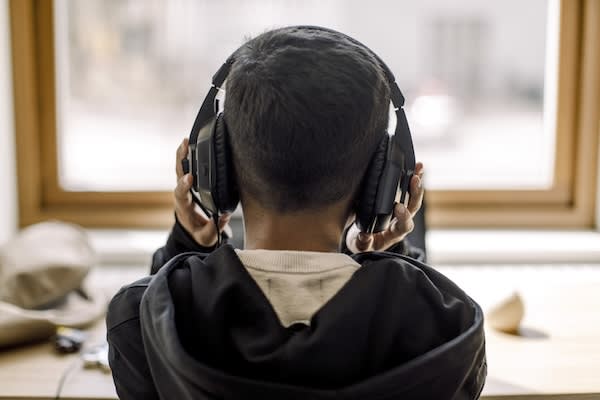
[5 MIN READ]
In this article:
-
One in 36 children has been diagnosed with autism spectrum disorder — and the numbers are rising every year.
-
One of the main reasons why there are more cases of autism is because there is a much higher rate of early detection.
-
Providence offers cutting-edge treatment for children of all ages who have been diagnosed with autism.
Early signs of autism in toddlers: A guide for parents
It’s hard to be a parent: You want to do what’s best for your child — but you also don’t want to overthink any symptoms of a potential disorder. You try not to compare your child to other children, but sometimes, it’s hard not to notice when your little one acts differently than others their age.
According to the Centers for Disease Control and Prevention, one in 36 children has been diagnosed with autism spectrum disorder (ASD). But it is a spectrum, which means the symptoms one child experiences could be different from another’s.
Understanding autism spectrum disorder
Autism spectrum disorder refers to a range of disorders that cause difficulties with communication and social, verbal and motor skills. Because it’s a spectrum, each person with autism has different strengths and challenges. While some people could need daily support, others may be able to function with very minimal outside assistance (known as high-functioning autism).
“We teach parents to look for the signs and symptoms of autism so we can catch and treat it early,” says Emily Morgan, Ph.D., a psychologist at Providence Pediatrics – Southwest in Portland, Oregon.
So, how do you know if your toddler is showing signs of autism spectrum disorder? Here’s a guide.
Signs of autism in 1-year-olds
Every baby develops at a different rate, which is why it can be difficult to spot signs of autism in children younger than 1. But by the time a child is 18-24 months old, there are certain milestones they should be reaching.
Social interaction and communication
Some of the common communication signs of autism in 1-year-olds include:
- Limited or no speech (very few or no meaningful two-word phrases)
- A loss of previously acquired speech
- Difficulty in following simple verbal instructions
- Avoidance of eye contact
- Little or no response to hearing their name
Behavioral signs to notice
The most common behavioral signs of autism in 1-year-olds are:
- Only walking on their toes
- Rarely imitating others’ behavior and actions
- Showing an intense interest in certain objects above others
- Not being willing to share objects or activities in which they are interested
- Engaging in repetitive movements or repetitive behaviors
Recognizing autism in 2-year-olds
Pediatricians and family doctors now offer the Modified Checklist for Autism in Toddlers-Revised at well-child visits, says Dr. Morgan. But you can also study the checklist at home and bring the results to your doctor.
Developmental milestones and delays
Some of the developmental delays that a 2-year-old with autism might experience include:
- Not noticing when others are hurt or sad
- Not engaging in pretend when playing
- Not noticing other children and wanting to play with them
- Not asking “who,” “what,” “when,” “where” or “why” questions
Physical and emotional signs
Physical and emotional signs of autism in a 2-year-old could include:
- Getting upset if they don’t like a certain taste or sound
- Not smiling when you smile at them
- Making repetitive or flapping movements with their hands
Identifying autism in 3-year-olds
Autism spectrum disorder is most commonly diagnosed at the age of 3 or later. This is when signs and symptoms become more apparent, including:
- Delays in speech and other developmental milestones
- Responding to a question by repeating it, rather than answering it
- Loss of previously acquired speech
- Avoiding eye contact
- Not responding to their name
- Preferring not to be touched, held or cuddled
- Not showing facial expressions or emotions such as happy, sad or upset
- Lining up toys
- Banging their head or having tantrums
- Not engaging in pretend play
- Having a peculiar attachment to inanimate objects
Dr. Morgan also recommends using the CDC’s Learn the Signs. Act Early. resource to check on your child’s progression with their milestones.
Why are autism diagnoses rising?
Researchers have reported that young adults in the United States between the ages of 26 and 34 experienced a 450% increase in autism diagnoses between 2011 and 2022. During that same study period, new diagnoses rose by 185% in boys and 305% among girls.
So, is autism becoming a more prevalent condition? Yes, in the sense that it’s becoming diagnosed more often. “It’s more that the increase is seen because of our ability to detect it,” Dr. Morgan says. “There have been very steady increases in screening, policy and access to care.”
Dr. Morgan also points out that some children, especially girls, may exhibit “camouflaging” in early childhood. This means that while they are on the autism spectrum, they might have figured out how to mask their social skills to be like other children. "For example,” she says, “it could be considered masking or camouflaging when someone mimics the facial expressions and emotional reactions others are displaying in order to navigate the context. They may not fully understand why others are displaying those expressions, and therefore could possibly benefit from learning social skills such as perspective taking and empathy."
According to the referenced study, which was published in the Journal of American Medicine in October 2024, the reported rates of autism are likely still lower than the actual rates. Young adults who were not diagnosed in childhood continue to get screened, which means cases will continue to rise.
How autism is diagnosed
If you wonder whether your child might have ASD, you should take them to see their pediatrician. You can request a screening at any time from your doctor or your state’s early intervention program.
The American Academy of Pediatrics recommends that all children get screened for autism in early childhood, preferably around their 18- or 24-month exams. Screening, however, does not lead directly to a diagnosis of autism. Rather, it lets caregivers know if they should order a formal evaluation. This evaluation can be performed by a psychologist, developmental pediatrician, speech-language pathologist or other specialist. They may observe your child, give them a structured test, ask the parents or caregivers questions or all the above.
According to the CDC, a diagnosis of ASD now includes several conditions that used to be diagnosed separately: autistic disorder, pervasive developmental disorder not otherwise specified (PDD-NOS) and Asperger syndrome.
Even in visits that are not related specifically to autism, providers are always on the lookout for signs. “While I’m engaging with each patient, I’m just keeping the wheels spinning at the back of my mind,” Dr. Morgan says. “There are certain behaviors a child may exhibit that may prompt us to screen or refer for testing.”
The most commonly used test is the Autism Diagnostic Observation Schedule 2 (ADOS-2), a standardized interactive evaluation used with children who are 1 year and older. It includes play, conversation and observing a child’s responses to social cues.
Questions to ask your health care provider
If your provider suspects your child may have autism, the following are some of the follow-up questions you may want to ask during the diagnosis process:
- Why do you suspect autism?
- What are the diagnostic criteria for autism?
- What are the different types of autism, and how do you determine the level of severity?
- How will this impact my child’s life?
- What are the next steps, and how can I receive support?
Support from the Providence Autism Center
It may give you some relief to have a definitive diagnosis for your child’s condition, but that doesn’t make the path forward any easier. The biggest question many parents have immediately following an ASD diagnosis is, “What now?”
The Providence Boyden Family Autism Center, located at Providence Regional Medical Center in Everett, Washington, offers both diagnostic services and applied behavior analysis (ABA) therapy. We provide diagnostic assessments for children as young as 18 months, and we will give you feedback about your child the day of the evaluation.
We offer two main routes for treatment:
- The Intensive Day Treatment Program (IDTP) is a 12-week program designed for young children between ages 2 and 5. Children receive three hours of therapy for four days each week. The therapy helps them improve their communication skills and social interaction through play-based teaching strategies.
- Graduates of the IDTP can participate in the Bridging Program, which focuses on individual therapy for up to one year after the IDTP. Therapy rooms are designed as “centers,” throughout which the children rotate during their session, giving them the opportunity to interact with other children. We also provide additional support and care coordination services to help our families.
It’s certainly not easy to parent a child who has autism. But when you have the right resources and providers who care about your child as much as you do, it can be much easier to handle.
Contributing caregiver

Emily Morgan, Ph.D., is a psychologist at Providence Pediatrics – Southwest in Portland, Oregon.
Find a doctor
If you are looking for a Providence provider, search for one in our provider directory.
Download the Providence app
It’s all in the app: easily stay connected with Providence and your health. With the Providence app, you can schedule appointments, have virtual visits from the comfort of your own home, get health recommendations personalized for you, access your health records and so much more. Learn more and download the app.
Related resources
Top tips to prevent bullying in schools
Mental health help is just a mouse-click away
This information is not intended as a substitute for professional medical care. Always follow your health care professional’s instructions.
About the Author
More Content by Providence Health Team





















